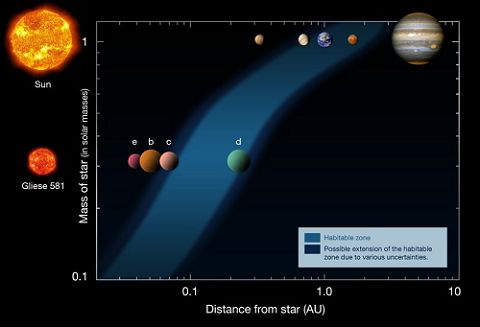Time:2011-04-08ClickTimes:
A paper entitled “Radiative constraints on the habitability of exoplanets Gliese 581c and Gliese 581d” by Prof. Yongyun Hu and his graduate student Feng Ding in the Dept. of Atmospheric and Oceanic Sciences was published on the journal of Astronomy & Astrophysics, 526, A135 (2011).
Are there habitable exoplanets in the Universe? Is there life on other planets? These fundamental issues have intrigued human curiosity throughout the ages. By 2011, there have been more than 500 extra-solar planets (exoplanets) discoveried. However, most of them are giant gas planets. In 2007, two relatively low-mass exoplanets, Gl 581c and Gl 581d, were observed orbiting the M-type star Gliese 581. Because their minimum masses are about 5 and 8 times larger than Earth’s, they are considered terrestrial planets or super-Earth, and they are the most likely habitable exoplanets discoveried in so far.
The habitability of an exoplanet is determined by many factors. One of the most critical and necessary conditions is that there exists permanent liquid water on the surface of the exoplanet, requiring that its surface temperature be above the freezing point of water (273 K), but lower than the runaway greenhouse threshold (340 K). The surface temperature of a planet is largely constrained by levels of greenhouse gases in the atmosphere, in addition to being determined by stellar radiation and the distance between the planet and its parent star. To study how the habitability of Gl 581c and Gl 581d is constrained by radiative properties of their atmospheres and the threshold of carbon-dioxide (CO2), Prof. Yongyun Hu and his graduate student Feng Ding used real-gas radiative-convective atmospheric models to calculate surface temperatures of the two exoplanets for various levels of CO2 and water vapor, assuming that the two exoplanets are terrestrial, and that they have similar outgassing processes to those of the terrestrial planets in our own solar system. Their simulation results suggest that Gl 581d is probably a habitable planet, and about 5-10 bars of CO2 is sufficient to raise its surface temperature above 273 K. In contrast, Gl 581c might have experienced runaway greenhouse, like Venus, because of its too high surface temperature and the lack of an effective cold trap for water vapor.

| 
|
Figure 1. Illustration of habitable zones in the solar and the M-type star
Gliese 581 systems. The blue band indicates the habitable zone.
| Figure 2. Simulated vertical temperature profiles for Gl 581d.
It shows that lees than 10 bars of CO2 can raise the surface temperature above 273 K.
|
